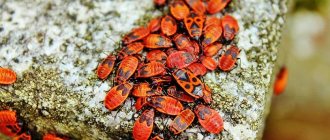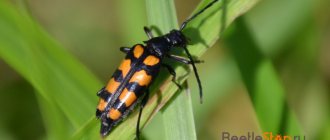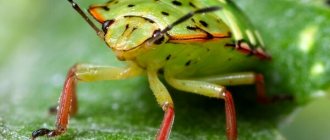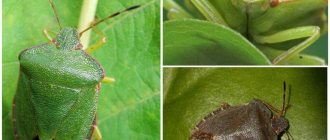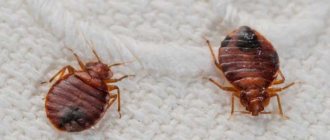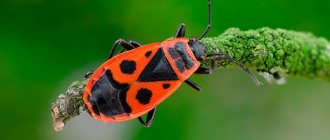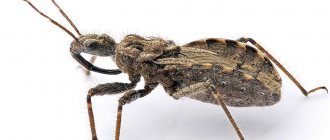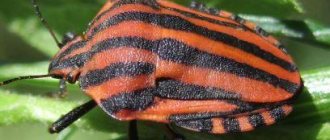Insects are divided into Coleoptera and Hemiptera. The stink bug belongs to the second category. Found on bushes and trees. Occasionally they can harm fruit trees. They are also beneficial for the garden. The shape and color of representatives may vary. The name of the insect was not given by chance. On the back of the representative there is a kind of shield. The cover is hard. Insects are able to change color depending on environmental conditions. This is necessary for successful disguise. It is the back that provides safety to the insect.
The stink bug is a small beetle that can change color
What are the features of appearance and structure
The body of the shield bug is flattened from above and below. The body has 5 segments. The top has:
- triangular head;
- prothorax with pointed corners;
- shield;
- dense fenders;
- membranous wings.
The lower part is also divided into 6 segments. The spiracles are located along the edges. The insect has special glands necessary to secrete a substance with a pungent odor. This is necessary to scare away enemies and attract females.
It is wood bugs that emit the most pungent odor among their relatives. The insect marks its territory with a scented substance. It is a deadly poison for some insects. The mouthparts are piercing-sucking. There is a pointed proboscis.
Wood bugs can produce a very strong odor
An insect can be either carnivorous or herbivorous. This directly depends on where you live. It is with the help of the proboscis that the bug pierces leaves and fruits. The stink bug is attracted to raspberries. If it is absent, other shrubs may occupy the garden plot.
The insect can feed on dead small organisms. The shield insect injects enzymes into the food object. This makes the process of eating food easier.
Wintering is carried out close to food. The green bug hides under fallen leaves. The forest representative climbs under the bark of trees. The bug becomes active after the onset of spring. The insect comes out in search of food after warming.
There are large compound eyes on the shield's head. Closer to the shield there are two simple eyes. The insect also has long whiskers. The shieldfish is excellent at camouflage. This is possible thanks to the ability to adapt to environmental conditions.
Variety of stink bugs
Almost everyone has encountered a beautiful striped beetle in the garden or field[/caption] There are many varieties of stink bugs, which may prefer different foods.
- The two-toothed shield bug, which has a brown, closer to brown, back color, hunts and devours small caterpillars and other small insects.
- The American bug, which has an elongated brown back and massive hind legs like a grasshopper, prefers to suck the juices from young cones, causing them to rot.
- The soldier bug has the same elongated back, but is covered with an aggressive black and red pattern, which consists of bright red stripes and round spots of the same color at the bottom of the body. It settles on the ground and loves to eat small insects, as well as its relatives, of course, not disdaining the juices of any plants that it encounters on its way.
- The line bug (minke bug, tiger bug) is similar to an ordinary forest bug, it has approximately the same shape of the back, but at the same time it has bright orange stripes on the back and does not even try to camouflage itself, like its green relatives, due to the fact that for insects and it is poisonous to birds.
- In addition to the usual feeding on grass juices for bugs, the linear stink bug loves to drink juices from umbrella plants. The favorite habitats of such bugs are dill and parsley bushes. He does not disdain carrot tops, for which he has a bad reputation as a parasite among farmers and summer residents.
What are the varieties?
There are many subspecies of insects. Some of them are pests. In total, there are about 4,000 species of bugs from the stink bug family.
There are many types of stink bugs
The main types of insects are presented in the table.
| Forest green | The insect feeds on sap from trees and shrubs. Also prefers cultivated plants. The shield bug often occupies gardens and lives on raspberries. Is a pest. |
| Cruciferous | Looks like a soldier bug. The invasion of the parasite leads to the complete destruction of cultivated plants on the site. |
| Pear | Eats fruit trees. |
| Cucumber | Body length does not exceed 3 mm. Settles on the lower leaves. The insect can jump over a long distance. |
| Horsefly | It parasitizes almost all garden crops. |
Among the representatives there are both beneficial and parasites.
Insect species
The stink bug family is characterized by brightly colored, medium to large sized ground bugs with flat, scute-like backs. Of the varieties, the families of true shield bugs, earthen, hemispherical, woody or berry, turtle shield bugs and many others are known.
- The family of true shield insects has up to 4,000 species, the size of insects is from 0.8 to 1.8 cm, and more than 200 species live on European territory. Of the varieties of this family, the lined scale insect stands out with its bright color. He was nicknamed the Italian bug for his red back with black stripes, similar in color to the uniform of the Vatican guards.
- The earthen shield family has more than 700 species, lives on the surface of the earth, feeds on roots and is harmful to some types of cereals and peanuts. The family of hemispherical shield bugs includes more than 500 species, ranging in size from 0.2 to 2 cm; representatives have a rounded shell reaching to the abdomen.
- The family of shield turtles is small in number, numbering no more than 100 species. An insect ranging in size from 0.6 to 1.5 cm. They are considered the most powerful agricultural pests, live in fields, and feed on plant sap.
- Wood bugs are a family of no more than 200 species. The size of the insect can be from 0.5 to 3.5 cm. They live on trees and shrubs, feeding on foliage. The most famous varieties are the green and gray wood stink bug and the berry stink bug.
- The gray stink bug is a small bug, 0.5 to 0.8 cm long. Habitat: trees such as birch, beech, holly, alder, spruce. The green shield bug or berry bug is a large insect up to 3.5 cm long, lives on trees and shrubs, often in raspberry fields, feeds on the juice of leaves and berries. It is considered a pest of agricultural crops.
The picture shows the types of bedbugs:
- edge worker;
- sharp-headed shieldbill;
- Italian stink bug;
- green tree shield;
- subcorn;
- smoothie;
- predator;
- shield catatacanthus incarnatus;
- bed bug;
- streaked rower;
- ranatra;
- sea water strider;
- shieldweed "senator";
- water bug;
- stink bug Chrysocoris silatus;
- edge worker;
- skinny bug;
- water scorpion;
- soldier bug.
Wood bug
The wood bug has a large, flat body. Coloring
the insect depends on the time of year: in summer it is light green, merging with the green of summer foliage; closer to autumn, the green color is diluted with brownish-brown spots, and at the height of autumn the insect merges with the crimson-orange color of autumn trees.
In the back of the body, brown wings are hidden under the shield, which the bug does not use very often. Its wings have a small span and insufficient strength for the insect to take off easily, so getting into the air is a very energy-consuming task for the bug.
The stink bug makes flights only when it is necessary to search for new food.
What is the reproduction and development cycle?
Before mating, the male circles the female and touches her with his antennae and head. For fertilization, the insect inserts its genital organ into a special hole on the body. Seminal fluid is used as needed.
The female lays eggs, which hatch into small larvae
If conditions are favorable, the female lays eggs twice per season. Each clutch contains 100 eggs. The shell has a light green color. Young individuals are deposited on leaves.
After 15 days hatching will occur. The larvae have an incomplete metamorphosis cycle. Practically no different from imago. Immediately after emerging, the worm begins to actively feed.
The larvae go through 4-5 molts. The color of the chitinous cover changes as it matures. The entire development cycle takes 1-2 months, depending on the subspecies.
It is interesting to know that this bug is used to prepare a tincture to combat alcoholism. In this case, the addicted person develops a gag reflex and an aversion to alcohol-containing drinks.
Only after all the molts do the insects develop wings. The insect rarely flies. Uses wings only when absolutely necessary. Occasionally the representative travels long distances. A dark spot appears at the puncture site of leaves and berries.
This video talks about one of the subspecies of shield bugs:
What does a berry bug look like?
The berry shield is a relatively small representative of its family. The length of its body is only 10-12 mm. An adult insect is capable of changing its color, adapting to the color of the surrounding foliage. So, for example, in the summer you can meet a bug with a bright burgundy color, and in the fall the same insect will wear brownish-brown clothes.
The sides and tendrils of the berry plant with black and yellow transverse stripes look very impressive. By this characteristic pattern it can be easily distinguished from other shield insects.
The larva is very similar in appearance to the adult insect, but has a gray camouflage color without a bright rim on the sides and is completely covered with light fluffy hairs.
Over time, she will lose her baby fluff and wear a bright adult outfit. However, this will not happen earlier than a month and a half.
During the entire period of growing up, a small stink bug will shed its skin 5 times before reaching the adult stage.
Females lay their eggs on plant leaves and the surface of berries in May–June. Within a week, small bugs appear from them, which at first stay in a group, and then spread throughout the entire plant.
Contrary to its name, the berry bug does not feed solely on the fruits of gardening. It can be found on various plants, including weeds. He loves rape and other herbs with juicy tender leaves.
When feeding, the insect pierces the leaves of herbs with its proboscis and sucks out the juices from them. Subsequently, the damaged area turns pale and dries out. If there are a lot of pests, the plant may soon die.
Advice! To protect the garden from attacks by berry bugs, it is necessary to promptly remove last year’s foliage and carry out scheduled treatments of the area against pests.
Shield bugs - who are they?
Shield insects are a fairly large family. There are more than 4,000 species in the world. Among them there are not only herbivores, but also predators. For example, the tree bug attacks caterpillars and small insects, sucking the life juices out of them. The predator can be distinguished by its thick proboscis, specially adapted for piercing the integument of its victims.
By the way, in appearance the tree bug looks quite similar to its herbivorous relative, however, if you look closely, the berry bug looks a little different. Even in the fall, when its color fades, the characteristic stripes on the sides of the body will not allow you to make a mistake.
A characteristic feature of all stink bugs is a sharp, unpleasant odor emitted by insects from the holes on the abdomen. It is to this aroma that stink bugs owe their second name – stink bugs. It is quite difficult to get rid of the nasty smell, so insectivorous predators and other animals try to avoid stink bugs.
Interesting fact! The odorous secretions of stink bugs are none other than cimicic acid. For insects, it is a contact poison and in large quantities can cause paralysis and death of a predator that dares to attack the stink bug.
Is stink bug dangerous for people?
It is believed that insects living in gardens do not pose a danger to humans. The proboscis is soft and cannot pierce the skin. Despite this, cases have been recorded of the shield bug biting people. Against this background, scientists are trying to establish whether there are mutated forms that arose as a result of crossing the shield bug and the bed bug.
Triatomine bugs live in the tropics. Insects harm not only plants, but also mammals and animals. They are carriers of diseases.
Is the berry bug a pest?
Despite the fact that the berry bug harms plants by drinking their juices, it does not cause much damage to gardens and vegetable gardens. The small number and omnivorous nature of this insect do not pose a particular threat to the harvest, so it can be a stretch to call it a pest.
Berry shields do not like to show themselves off and prefer to sit peacefully somewhere on a bush, drinking sweet plant juice. They most likely got their name precisely because of their inconspicuousness, since only by inadvertently grabbing a berry favored by a bug and smelling its smell, we notice it and call it stinky in our hearts.
You can find out what representatives of the shield family look like in nature by watching the video:
How harmful is the parasite?
Some insects negatively affect the plants they live on. The representative eats leaves and fruits, leaving behind brown marks. When stink bugs invade, the entire crop can be destroyed. Favorite treat: raspberries.
Bed bugs love raspberries
The insect leaves an unpleasant odor from the glands on the berries and leaves. With a lack of glands, the insect switches to agricultural crops, namely cereals. Often a representative lives in an apartment.
When an insect enters an apartment, it does not harm residents. The only negative is the unpleasant aroma from the parasite.
Bedbug lifestyle
The shield bug spends the winter in a daze, burrowing into fallen leaves. In the spring it “comes to life” and enters the breeding season. In summer, the quiet and inconspicuous tree bug usually sits modestly on branches.
The green shieldfish rarely flies, only in cases of special need, being in full confidence that a hearty meal awaits it ahead. It takes too much energy for a bug to rise into the air. Its wings have a small span and do not provide sufficient lift.
See also our experiments on bedbugs:
We catch bedbugs and test different products against them - see the results...
- We test the effect of Hector powder on bedbugs in two options: simple treatment and preparation of traps. See the results of the experiment.
Experiment on bedbugs: at what temperature do they die and how it can be used in practiceWe put the bedbugs in a container that was treated with the Executioner product a week ago - we’ll see if the parasites are poisoned by the long-dried product...
- We tested the Get Express product on bedbugs - let's see what came out of it...
Experiment on bedbugs: The executioner killed them in 8 minutes
We check the residual effect of the Executioner on bedbugs (how quickly they are poisoned upon contact with a previously treated but already dried surface)
- Proven methods of killing bedbugs that have shown to be highly effective
The green tree bug has earned particular dislike, primarily because of the characteristic unpleasant odor that the insect emits when in danger. And the second serious reason to treat it negatively is the bug’s ability to cause damage to agricultural plants.
It is also useful to read: About the smooth water bug and the giant white stoma
And one more thing: Rating of bedbug repellents: choosing the best option
The bug has a detrimental effect on the plant in whose foliage it hides. Of course, for large shrubs its harm is almost insignificant; only small brown spots on the leaves indicate that the wood bug has been feeding here. Its jaws are adapted for feeding on plant juices.
But not only raspberries are food for the green bug. It, like other stink bugs, can feed on the sap of most deciduous trees and succulent grasses, and sometimes causes damage to grain fields.
The woodbug is not a “convinced vegetarian”, it does not refuse animal food, however, it does not know how to hunt for insects, and finds their remains in the forest litter.
Is it necessary to fight
The fight should only begin when necessary. If there are several beetles in the house, it is enough to collect them and take them outside. Active control should begin when the pest appears in the garden plot. Treatment with pesticides will be required. If this is not done in time, the crop will be destroyed.
Factors that increase the risk of a beetle entering a home include:
- attraction by artificial light;
- enduring a natural disaster;
- accidental ingestion with fresh fruits and vegetables.
You can bring the insect with vegetables and fruits
What are the methods of struggle?
The fight against the parasite on the site must be comprehensive and timely. Basic methods:
- chemical;
- mechanical.
The chemical method involves the use of chemicals. Solutions are available in the form of sprays, powder and liquid for creating solutions.
With the mechanical method, the usual collection of insects by hand is recommended. Additionally, the use of traditional methods is allowed. When fighting, the main thing is an integrated approach.
What chemicals are effective?
Chemicals are used as a last resort when other methods have failed. This is due to the fact that residues of the substance will accumulate in the soil and plants.
Experts recommend giving preference to the drug Actellik. This is a universal long-acting remedy. After entering the body of an insect, it destroys the nervous system. The performance of all internal organs is inhibited. This leads to the death of the representative. When processing, you need to wear gloves, a protective suit and a respirator.
To combat bedbugs you can use Actellik
Another effective drug is Vantex. The product has a contact-intestinal effect. The medicine is low toxic. Does not harm plants when used correctly. The main advantage of the solution is moisture resistance. The poison continues to act even after rain or other precipitation.
What are the folk ways of fighting?
A solution based on a mustard mixture showed good results in the fight against parasites. To prepare, you need to mix 10 liters of water and 100 g of mustard powder. The components are thoroughly mixed and sprayed with a spray bottle.
Solutions based on onions and garlic are popular. To prepare the onion medicine, take a medium vegetable and a glass of water. Chop the onion and add water. Leave to infuse for 7 days. Strain the liquid and use to wipe the leaves.
The safest method is to manually collect insects from the site. Scented plants are planted on the territory to repel bedbugs, for example, cumin, basil, and black cohosh.
